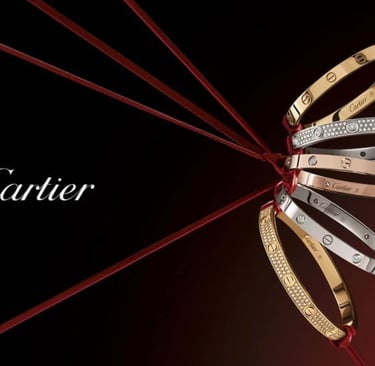From Paris to the World: The Maison's Enduring Global Footprint
11/9/20253 min read


The glint of a panther's emerald eyes, the perfect symmetry of a love bracelet, the unmistakable red box, these symbols transcend language, borders, and time. When a Parisian craftsman first opened his modest jewelry workshop in 1847, few could have predicted that nearly two centuries later, this name would become synonymous with luxury across six continents. The journey of Cartier from a single Parisian atelier to a global icon offers profound insights into how heritage brands navigate international expansion while maintaining their cultural essence.
The Foundations: From Rue Neuve des Petits Champs to Global Recognition
The story begins on Rue Neuve des Petits Champs, where Louis-François Cartier acquired the workshop of his master, Adolphe Picard. The early years were marked by meticulous attention to craftsmanship and a growing clientele among Parisian society. However, it was under the leadership of the founder's grandson, Louis Cartier, that the maison began its true global journey.
The Belle Époque provided fertile ground for expansion. By 1902, Cartier had established a presence in London, followed by New York in 1909. These were not merely retail outposts but carefully cultivated embassies of French luxury, strategically positioned to engage with new markets while maintaining the essence of Parisian sophistication.
Cultural Diplomacy Through Design
What distinguishes Cartier's global expansion from mere commercial growth is its profound engagement with diverse cultural aesthetics. The early 20th century saw the maison absorbing and reinterpreting artistic influences from around the world:
The geometric precision of Islamic art informed the clean lines of Art Deco pieces
Indian maharajas commissioned spectacular pieces incorporating their ancestral gemstones
Japanese motifs inspired new interpretations of flora and fauna in jewelry design
The "Tutti Frutti" style, featuring carved colored gemstones in the Indian tradition, exemplifies this cross-cultural pollination. Rather than imposing a singular French aesthetic globally, Cartier created a design language that spoke simultaneously of Paris and the world, a remarkable achievement in cultural diplomacy through artistry.
Beyond Jewelry: Expanding the Universe of Luxury
The maison's expansion extended beyond geographical boundaries to encompass new product categories. The introduction of the Tank watch in 1917, inspired by the modernist lines of military tanks from the First World War, demonstrated how Cartier could translate contemporary influences into timeless design. Similarly, the development of leather goods, fragrances, and accessories expanded the brand universe while maintaining coherence with its core identity.
This horizontal expansion required exceptional discipline in design governance. Each new category needed to honor the maison's design codes, the panther, the C motif, the particular shade of red, while adapting them to entirely different materials and functions.
Navigating the Tension: Heritage and Innovation
Perhaps the most remarkable aspect of Cartier's global journey is its navigation of the central tension facing all heritage luxury brands: how to honor tradition while embracing innovation. The maison demonstrates that these forces need not be contradictory but can instead be complementary.
The Santos watch, created in 1904 for Brazilian aviator Alberto Santos-Dumont, represents this balance perfectly. It was simultaneously revolutionary, one of the first purpose designed wristwatches for men, and classically Cartier in its elegant square case and exposed screws. Throughout subsequent decades, this pattern repeated: innovation in materials, complications, and design always occurred within the framework of the maison's established aesthetic vocabulary.
The New Silk Roads: Asian Markets and Digital Transformation
The late 20th and early 21st centuries presented new frontiers for Cartier's expansion. The rapid development of Asian economies, particularly in Japan, China, and later Southeast Asia, opened markets with both appreciation for heritage and hunger for status symbols. Cartier's approach to these markets demonstrated sophisticated cultural sensitivity, recognizing the need to adapt retail experiences, communications, and even product offerings while maintaining the integrity of the brand.
The digital revolution represented an equally significant challenge. How could a brand built on tangible craftsmanship and in-person service translate its experience to digital channels? Cartier's response has balanced technological adoption with a steadfast commitment to human connection. Digital platforms serve primarily as gateways to deeper engagement rather than endpoints in themselves.
Lessons for Global Luxury Leaders
Cartier's journey offers valuable insights for luxury brands navigating international expansion:
Cultural fluency trumps cultural imposition, the ability to absorb and authentically reinterpret diverse influences creates deeper connections than exporting a rigid aesthetic
Expansion requires both consistency and adaptation, maintaining core design principles while allowing for regional preferences
Heritage provides differentiation in new markets, authenticity and provenance create unique value that cannot be easily replicated
Innovation must serve the brand identity rather than dilute it, technological advances should enhance rather than replace traditional craftsmanship
The red box that once traveled from Paris to the courts of Europe now appears in the world's most dynamic emerging markets and digital platforms. Yet inside, the promise remains unchanged: exceptional craftsmanship, timeless design, and the weight of history. Therein lies the essence of Cartier's enduring global footprint, not merely a commercial presence spanning continents, but a cultural conversation continuing across generations.
